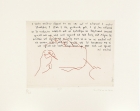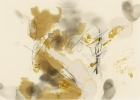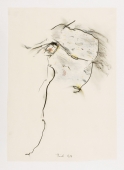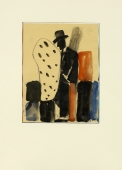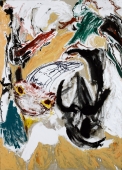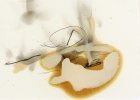
Artist | Claes Oldenburg (1929 - 2022)
Alias: Claes Oldenburg [Claes Thure Oldenburg]
https://www.artist-info.com/artist/Claes-Oldenburg
Biography (deutsch)
Biography (deutsch)
Claes Oldenburg wird 1929 als Sohn schwedischer Diplomaten in Stockholm geboren. 1946-1950 studiert er englische Literatur und Kunst an der Yale University New York. Eine erste Einzelausstellung findet 1959 in der Cooper Union Museum Library in New York statt. Oldenburg lernt Allen Kaprow und dessen Happenings intensiv kennen. Theater und Environments interessieren den Bildhauer ebenso wie die ideologische Bedeutung von Räumen. Oldenburgs erstes eigenes Happening trägt den Titel "Snapshot from the City". Ebenso gibt es Kontakte zur Fluxus-Szene. "The Store", das Projekt eines Kunst-Kaufhauses, entsteht 1961. Anfang der 60er Jahre arbeitet er an Filmprojekten und seinen ersten "Soft sculptures". Ab 1963 entstehen "Bedroom Ensembles", bald darauf erste Skizzen für große öffentliche Monumente. Bereits 1966 findet seine erste große Retrospektive im Stockholmer Moderna Museet statt. Oldenburg ist mehrmaliger documenta-Teilnehmer. Seit 1976 entstehen großformatige Projekte in Zusammenarbeit mit seiner zweiten Frau Coosje Van Bruggen.
About the work (english / deutsch)
About the work (english / deutsch)
Bedroom Ensemble
In the summer of 1963 Oldenburg was asked to construct an environment for a group exhibition in the Sidney Janis Gallery along with Jim Dine, James Rosenquist and George Segal. He began to create sketches, collages and miniature models of pieces of furniture most of which were to become elements of the Bedroom Ensemble (1963). Several of the sketches from the notebooks, hanging in the Oldenburg-room, show the first designs for the furniture of the Bedroom Ensemble. One can see, for example, designs for the bed with the little bedside table and the lamps as well as for the Zebra-chair or for the dressing table. Others show schematically drawn furniture und studies of objects in the U.S.Home. The artist stuck advertisements for beds, cut out of newspapers, on to some of the pages of the notebook where the beds were shown in strongly shortened perspective which served him as drafts for the furniture.
The Bedroom Ensemble dating from 1963 (from which the museum owns a replica from 1969 that the artist made for a retrospective of his works in the Hayward Gallery, London) was tailor-made by Oldenburg specially for a room in the Sidney Janis Gallery. The room in the gallery had the character of a flat. The walls were painted in a grey colour chosen by Janis himself, the floor was carpeted, in one of the walls were windows with drawn Venetian blinds and air-conditioning, a sign with the words "Private“ was fixed to a door. Oldenburg transferred all these details into his environment in the form of a complete ‘Living-Room’. All furnishings in the Bedroom radiate the coldness of stylized perfection which reminds us of advertisements [The „bedroom as a tomb“ (Oldenburg)]. The furniture in its entirety is formed out of synthetic materials. The large bed in the background has been made from black patterned vinyl, whilst the covers and the pillows are of the smooth white variety. The headboard, the beautifully draped cushions and the chair standing in the foreground on the right have been covered with synthetic materials imitating zebra skins. Oldenburg had the bedside tables and the dressing table produced in blue, marbled formica; the lampshades are made from marbled paper. The circular mirror on the dressing table has a deliberate dullness as if steamed up. The small objects, the radio, the powder boxes, the ash tray, the clock without hands are anonymous white things. The bedside rug emits sterile artificiality. The printed fabric stretched over the frames hanging on the walls is a standardised version, suitable for the consumer, of abstract-expressionist painting hinting at the work of Jackson Pollock. Together with the synthetic imitation of a leopardskin coat and a black patent handbag on the chair it epitomizes the height of an ideal, American, middle-class lifestyle. All the furniture and objects are without a function, they are ‘dead’ objects. They radiate coldness and uniformity. Everything seems to be frozen within a timeless room. The furniture, informalistic alienation, is a group of parallelograms which protrude aggressively into the room, the forms of which the artist had based on advertising leaflets corresponding to the repelling, overstylized materials. Oldenburg used some of the advertisment illustrations upon which the furnishings were based to make collages which are hanging on the opposite wall of the room. The materials and the alienated forms allow the bedroom to become the projected idea of a bedroom. The materials have optical but no haptic qualities thus excluding any possible erotic feeling. The perspectively distorted pieces of furniture may be ‘abstractions’ of objects, but it is exactly due to their making the subjectivity of awareness apparent, that we gain a sharpened perception of the human ‘perspecitve’ as one which is determined by particular regularities. The work’s real reference to the living world of the sixties is offset to some extent through the marked anonymity and ‘timelessness’ of the room and it is brought back again and again into the viewer’s present time. Due to this, the viewer projects that which he perceives into his own living world and reflects upon it.
Bathroom
In the so-called ‘bathroom’, a plain room of the museum within which the artist set up his works himself, the following objects can befound: the huge hard and soft versions of the Light Switch, the Sketch of a Toilet which has been made from corrugated cardboard and styrofoam, a Toilet and a Washstand both of which consist of wood and cardboard constructions which have been painted and an Ashtray with burning cigarettes made from soft material. In the foreground of the room a largesized Soft Key and a Soft Typewriter flank the rest of the objects. A Drainpipe composed of styrofoam, corrugated cardboard and wood, an Underground Drainpipe and the Memorial and Tomb for John F. Kennedy as well as several sketches and drawings of these and other works by the artist are hanging on the opposite wall. All these works were created during the sixties and seventies. A Slice of Bacon in the form of a soft carpet, sewn out of canvas, was given as a permanent loan to the museum by the artist on the occasion of its opening. It nestles on the steps leading to a small balcony and protrudes provocatively - just a fraction - over the parapet and into the central hall of the building. A collage with the advertisement for a slice of bacon shows the preliminary stage of the work with regard to the subject matter.
In General
Oldenburg’s objects are relics of a "human landscape“, of everyday life. At the same time, through the various versions in soft and hard materials, he attempts to investigate, on the one hand, the independent existence of the objects and their material composition. On the other hand, he attempts to alter the balance of material opposites in the living world. Some objects appear abstracted and intangible, others as de-functionalized symbols of the everyday world whereas others again appear to be sensualized shapes, inviting us to touch them. Through the metamorphosis of objects into other unusual materials, Oldenburg created object paraphrases, which divert the observer’s view away the functional field of object association in society concentrating instead on the object as a plastic, aesthetic form. Soft becomes hard. Hard becomes soft. The objects become virtually ‘humanized’, suddenly emitting an individual aura, opening the boundaries to unusual levels of the senses. The world of objects is exempt from its laws. The boundaries flow between appearance and reality.
German text by Rolf Lauter / Translation by Jennifer Greitschus
(Extract - Full printed version available in the Museum)
MMK - Museum für Moderne Kunst, Frankfurt am Main
Schlafzimmer-Ensembles
Im Sommer 1963 wurde Oldenburg aufgefordert, für eine Gruppenausstellung in der Sidney Janis Gallery neben Jim Dine, James Rosenquist und George Segal ein Environment zu gestalten. Er begann, Skizzen, Collagen und Miniaturmodelle von Möbeln anzufertigen, von denen die meisten Bestandteile des Schlafzimmer-Ensembles (1963) werden sollten Einige Skizzen aus den Notizbüchern, die im Oldenburg-Raum hängen, zeigten die ersten Entwürfe, für die Möbel dieses Schlafzimmer-Ensembles, so u.a. für das Bett mit den Nachttischchen und Lampen, für den Zebra-Sessel oder für die Frisierkommode. Andere zeigen schematisch gezeichnete Möbel und Studien für Objekte des US-Heimes. Auf einige Notizbuchseiten klebte der Künstler aus Zeitungen ausgeschnittene Werbeanzeigen von Betten, die diese in stark verkürzter Perspektive zeigen und die als Gestaltungsvorlagen der Möbel dienten.
Das Schlafzimmer-Ensemble aus dem Jahr 1963, von dem das Museum eine Replik aus dem Jahr 1969 besitzt, welche der Künstler für eine Retrospektive seiner Werke in der Londoner Hayward Gallery anfertigte, wurde von Oldenburg speziell auf einen Raum der Sidney Janis Gallery zugeschnitten. Der Galerieraum hatte den Charakter einer Wohnung. Die Wände waren in einem von Janis selbst festgelegten Grau gestrichen, der Boden war mit einem Teppich ausgelegt, in einer Wand waren Fenster mit heruntergelassenen Innenjalousien und einer Klimaanlage, an einer Tür war das Schild 'Private’ angebracht. Alle diese Details übertrug Oldenburg auf sein Environment, das er als einen vollständigen 'Wohn-Raum’ nachbaute. Alle Einrichtungsgegenstände des Schlafzimmers strahlen eine stilisierte, perfekte, reklameartige Kälte aus (Das „Schlafzimmer als Grab“, Oldenburg). Alle Möbel sind aus synthetischen Materialien angefertigt. Das große Bett im Hintergrund ist aus gemustertem schwarzem, die Bezüge und Kissen aus glattem weißem Vinyl hergestellt. Die Abschlußplatte am Kopfende, die schön drapierten Kissen und der rechts im Vordergrund stehende Sessel sind mit Kunststoffimitaten aus Zebrafell überzogen. Die Nachttischchen und die Frisierkommode hat Oldenburg aus blaumarmoriertem Resopal fertigen lassen, die Lampenschirme aus marmoriertem Papier. Der Rundspiegel auf der Kommode ist gewollt stumpf und wie beschlagen. Die kleinen Gegenstände, das Radio, die Puderdosen, der Aschenbecher, die zeigerlose Uhr sind anonyme weiße Dinge. Der Bettvorleger strömt sterile Künstlichkeit aus. Die an den Wänden hängenden, mit bedrucktem Stoff umspannten Keilrahmen, deren Muster zum Konsum aufbereitete, standardisierte Varianten der abstrakt-expressionistischen Malerei eines Jackson Pollock sind, sowie das Kunststoffimitat eines Leopardenmantels und eine schwarze Lacktasche auf dem Sessel bilden die Krönung des bürgerlichen amerikanischen Lebensideals. Alle Möbel und Gegenstände sind funktionslose 'tote’ Objekte. Sie strahlen Kälte, Uniformität aus. Alles scheint in einem zeitlosen Raum eingefroren zu sein. Den abweisenden, überstilisierten Materialien entsprechen in formaler Hinsicht die zu Parallelogrammen verfremdeten, aggressiv in den Raum ausgreifenden Möbel, deren Form der Künstler in Anlehnung an Werbeprospekte gestaltet hat. Einige für das Mobiliar des Schlafzimmers vorbildhafte Reklamebilder hat Oldenburg zu Collagen verarbeitet, die an der gegenüberliegenden Wand des Raumes hängen. Die Materialien und die verfremdeten Formen lassen aus dem Schlafzimmer die Projektion der Vorstellung eines Schlafzimmers werden. Die Materialien haben optische, aber keine haptischen Qualitäten, schließen damit jedes erotische Gefühl aus. Die perspektivisch verformten Möbel sind zwar 'Abstraktionen’ von Gegenständen, schärfen aber gerade durch die Sichtbarmachung der Subjektivität der Wahrnehmung den Blick für die Bedingtheit der menschlichen 'Perspektive’ von bestimmten Gesetzmäßigkeiten. Der reale Bezug des Werkes zur Lebenswelt der 60er Jahre wird durch die fühlbare Anonymität und 'Zeitlosigkeit’ des Raumes teilweise wieder aufgehoben und immer wieder von neuem zu einem Raum der jeweiligen Gegenwart des Betrachters aktualisiert. So projiziert der Betrachter das Wahrgenommene auf seine eigene Lebenswelt und reflektiert sie.
Badezimmer
Im sogenannten 'Badezimmer’, einem einfachen Museumsraum, in dem der Künstler seine Werke selbst aufgebaut hat, befinden sich folgende Objekte: Die überdimensionierten harten und weichen Versionen eines Lichtschalters, der Entwurf einer Toilette, der aus Wellpappe und Styropor gestaltet wurde, eine Toilette und ein Waschtisch, die beide als Holz-Karton-Konstruktionen gearbeitet und bemalt wurden, und ein Aschenbecher mit brennenden Zigaretten aus weichem Stoff. Im vorderen Teil des Raumes frankieren ein großformatiger Weicher Schlüssel und eine Weiche Schreibmaschine die übrigen Objekte. An der gegenüberliegenden Wand hängen eine aus Styropor, Wellpappe und Holz zusammengesetzte Regenrinne, ein Unterirdisches Abflußrohr und das Grabdenkmal für John F. Kennedy sowie einige Skizzen und Zeichnungen zu diesen und anderen Werken des Künstlers. Alle diese Arbeiten entstanden in den 60er und 70er Jahren. Eine Scheibe Speck, die in Form eines aus Leinwand genähten, weichen Teppichs gearbeitet ist und dem Museum vom Künstler zur Eröffnung des Hauses als Dauerleihgabe übergeben wurde, schmiegt sich an die Stufen, die zu einem kleinen Balkon führen und hängt provozierend ein Stück über dessen Brüstung in die zentrale Halle des Gebäudes hinein. Eine Collage mit dem Reklamebild einer Speckscheibe zeigt die inhaltliche Vorstufe dieser Arbeit.
Allgemeines
Oldenburgs Objekte sind Relikte der „menschlichen Landschaft“, der Alltagswelt. Dabei versucht er anhand der verschiedenen Versionen aus weichen und harten Materialien einerseits das Eigenleben der Gegenstände, ihre materiale Beschaffenheit zu hinterfragen, andererseits das Gleichgewicht materieller Gegenstände in der Lebenswelt zu umschreiben. Manche Objekte wirken abstrahiert und vergeistigt, andere als entfunktionalisierte Symbole der Alltagswelt und wieder andere als versinnlichte Gebilde, die zum Berühren einladen. Durch die Übertragung von Gegenständen in andere ungewohnten Materialien schuf Oldenburg Objektparaphrasen, die den Blick des Betrachters von dem funktionalen Beziehungsfeld der Dinge in der Gesellschaft ablenken und auf den Gegenstand als eine plastische, ästhetische Form eingehen. Weiches wird hart, Hartes wird weich. Die Gegenstände werden geradezu 'vermenschlicht’, strahlen plötzlich eine individuelle Aura aus, eröffnen ungewohnte Sinnschichten. Die Objektwelt ist ihren Gesetzen enthoben. Die Grenzen zwischen Sein und Schein verfließen.
Text von Rolf Lauter
(Auszug - Der vollständige Text ist als Informationsblatt beim Museum erhältlich)
MMK - Museum für Moderne Kunst, Frankfurt am Main
Bibliography
Bibliography
Coosje van Bruggen: Claes Oldenburg. Nur ein anderer Raum. Museum für Moderne Kunst, Frankfurt am Main, Verlag Wilk, Friedrichsdorf, 1991.
ISBN: 3-88270-463-2
Claes Oldenburg: Multiples in Retrospect 1964-1990. Rizzoli International Publications, New York 1991.
Barbara Rose: Claes Oldenburg. New York 1970.
Claes Oldenburg, Coosje Van Bruggen: Large-Scale Projekts. Thames and Hudson, London 1995.
Coosje Van Bruggen: Claes Oldenburg: Mouse Museum/Ray Gun Win. Ausstellungs-Katatalog, Rijksmuseum
Kröller-Müller, Otterlo, Museum Ludwig, Köln, 1979
Claes Oldenburg: Object Into Monument. Hrsg. Barbara Haskell, Pasadena Art Museum, Pasadena California 1971.
Claes Oldenburg. Ausstellungs-Katatalog Städtische Kunsthalle Düsseldorf, 1970.
 offers / Requests offers / Requests  |
About this service |
|---|
 Exhibition Announcements Exhibition Announcements  |
About this service |
|---|
 Visualization |
Learn more about this service | ||
|---|---|---|---|

Interested in discovering more of this artist's networks?
3 easy steps: Register, buy a package for a visualization, select the artist.
See examples how visualization looks like for an artist, a curator, or an exhibition place: Gallery, museum, non-profit place, or collector.

Exhibition History

|
SUMMARY based on artist-info records. More details and Visualizing Art Networks on demand. Venue types: Gallery / Museum / Non-Profit / Collector |
||||||||||||
| Exhibitions in artist-info | 343 (S 65/ G 278) |
Did show together with - Top 5 of 3638 artists (no. of shows) - all shows - Top 100
|
||||||||||
| Exhibitions by type | 343: 120 / 145 / 75 / 3 | |||||||||||
| Venues by type | 180: 59 / 67 / 52 / 2 | |||||||||||
| Curators | 134 | |||||||||||
| artist-info records | Dec 1959 - Feb 2025 | |||||||||||
|
Countries - Top 5 of 17 United States (165) Germany (84) France (17) Switzerland (14) Netherlands (8) |
Cities - Top 5 of 83 New York (121) Berlin (17) Paris (13) Frankfurt am Main (13) Los Angeles (13) |
Venues (no. of shows )
Top 5 of 180
|
||||||||||
Curators (no. of shows)
Top 5 of 134
|
| Fondation Louis Vuitton - FLV | G | Oct 2024 - Feb 2025 | Paris | (11) | +0 | |
| Buchhart, Dieter (Curator) | +0 | |||||
| Hofbauer, Anna Karina (Curator) | +0 | |||||
| Château de Montsoreau-Musée d’art contemporain | G | Jul 2018 - Oct 2018 | Montsoreau | (7) | +0 | |
| Luxembourg & Dayan - New York | G | May 2016 - Jul 2016 | New York | (24) | +0 | |
| Centre Pompidou - Metz | G | Apr 2016 - Jul 2017 | Metz | (27) | +0 | |
| Lavigne, Emma (Curator) | +0 | |||||
| Fundação de Serralves | G | Feb 2016 - May 2016 | Porto | (22) | +0 | |
| Homem, Antonio (Curator) | +0 | |||||
| Braga, Isabel Sousa (Curator) | +0 | |||||
| LUDWIGGALERIE Schloss Oberhausen | G | Jan 2016 - May 2016 | Oberhausen | (4) | +0 | |
| Keep reading |


















